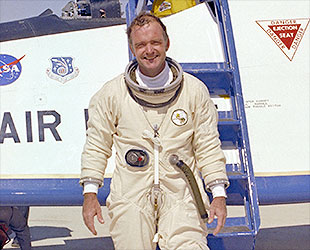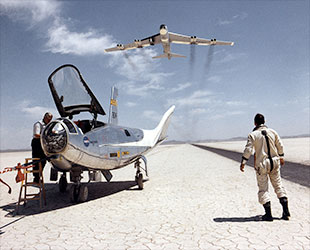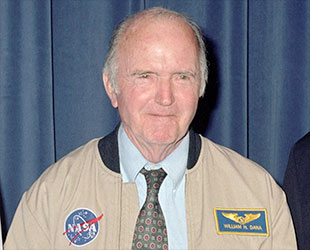May 7, 2014 – Bill Dana didn't receive his astronaut wings until almost 40 years after he flew in space.
Dana, who on Tuesday (May 6) died at the age of 83, flew the X-15 rocket plane on two flights that exceeded the Air Force-defined space boundary of 50 miles (80 kilometers) in 1966 and 1968. But, as he was a NASA research pilot and the space agency at the time did not issue wings to its pilots, Dana was not formally awarded his astronaut status until a NASA ceremony in 2005.
The delay did little however, to diminish Dana's long and distinguished career as a NASA test pilot and aeronautical engineer.
Over the course of 48 years working at NASA's Armstrong Flight Research Center (previously Dryden) at Edwards Air Force Base in southern California, Dana logged more than 8,000 hours in more than 60 different aircraft, ranging from helicopters and sailplanes to the hypersonic X-15. Several of the aircraft he flew are now exhibited by the National Air and Space Museum in Washington, D.C.

NASA test pilot Bill Dana pauses for a photo after flying the final powered flight of the X-24B lifting body on Sept. 23, 1975. (NASA) |
Dana was first hired as an aeronautical research engineer at NASA's then-High-Speed Flight Station on Oct. 1, 1958, the same day the space agency was established. His first assignments included development of an X-15 rocketplane performance simulator, and stability and control research involving the F-107A fighter prototype.
In September 1959, Dana transferred to the center's flight operations branch as a research pilot. Over the next three decades he conducted flight experiments in a wide variety of aircraft, including the rocket powered X-15 and wingless lifting bodies.
Dana flew the X-15 16 times, including the 199th and final flight of the research program. His two astronaut-qualifying flights reached 58.1 and 50.6 miles (93.5 and 81.4 km).
"The horizon appeared as a ring of bright blue around the shell of the Earth, with darkness above," Dana recalled in a 2007 NASA interview. "I knew I'd gotten all the altitude I needed to qualify as a space adventurer!"

NASA test pilot Bill Dana, standing next to the HL-10 lifting body, watches as a B-52 mothership passes overhead in 1969. (NASA) |
After the X-15, Dana was assigned to fly the HL-10, M2-F3, and X-24B lifting body aircraft to validate engineers' assertions that such vehicles could be precisely controlled during approach and landing, and providing NASA with the confidence needed to proceed with designs for the space shuttle.
In addition, Dana flew hundreds of research test flights in advanced jet fighters including the F-14, F-15, F-16, and YF-17. He performed a guest pilot evaluation of the X-29 forward-swept-wing technology demonstrator and flew the F-18 High Alpha Research Vehicle, the first aircraft to use multi-axis thrust vectoring for vehicle control.
Because of his demonstrated leadership and extraordinary service in flight research, Dana was appointed Chief Pilot in 1986 and was responsible for recruiting, developing and training NASA's cadre of research pilots. He also served as assistant chief of the flight operations division.
In 1993, Dana retired from flying to become the research center's Chief Engineer. In this new role, he oversaw all research projects and was responsible for flight safety. He held this position until his retirement from civil service in May 1998.

NASA test pilot Bill Dana wears his NASA astronaut wings after a 2005 ceremony that awarded him the distinction almost 40 years after he first flew the X-15 rocket plane into space. (NASA) |
Just seven months later, Dana returned to the center as a contractor to write analytical histories of various programs and to evaluate lessons learned. During a period of budget reductions, he gave up a salary and continued to work as a volunteer with the center's history office.
William Harvey Dana was born Nov. 3, 1930 in Pasadena, California, and raised in nearby Bakersfield.
His numerous awards and honors include the AIAA Haley Space Flight Award, NASA Exceptional and Distinguished service medals, Lancaster Aerospace Walk of Honor, and the Milton O. Thompson Lifetime Achievement Award. In 1996, he was honored in the "Salute to Test Pilots" at the Experimental Aircraft Association's convention.
He became a member of the Society of Experimental Test Pilots in 1961 and was elected a fellow in 1998.
